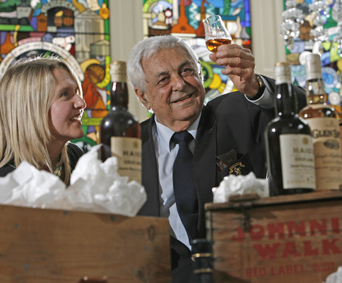Whisky has been much in the news of late thanks to Whisky Month and the launch of the Diageo Claive Vidiz Collection at Edinburgh’s Scotch Whisky Experience.
Comprising 3384 bottles of Scotch which he acquired over 35 years, Senor Vidiz’s whisky collection is breath-taking. A Brazilian business man, he sold it Diageo last year and they have lent it to the Whisky centre so that the public can enjoy it.
The bottles are displayed in a back-lit vault and, when you walk into the collection, the golden glow generated by the liquid almost seems magical. I did an interview with Claive Vidiz last week and he was as full of stories and anecdotes as you might expect from someone who has dedicated almost half of his life to hunting down rare and exotic whiskies.
As is perhaps the case with many people, Senor Vidiz didn’t immediately take to whisky. In fact, the first time he tried it, he had to go and lie down after just the one dram. Fortunately, he stuck with it and the results are well worth taking a look.
While at the Scotch Whisky Experience, I had a chat with Julie Trevisan Hunter who works there. Julie has been very active helping the centre’s Amber restaurant match whisky to food. Some of the whisky pairings were very straightforward: it’s a no-brainer that sherried malts go well with chocolatey desserts. More unexpected were her findings when it came to matching whisky with cheese. Apparently, big, peaty Islay malts go well with cheese, especially blue cheeses, and so do very light, delicate Lowlands such as Glenkinchie. But, while the two extremes of the whisky spectrum work well, most of the Highland and Speyside malts in the middle just get lost when paired with cheese.
Now, if you’ll excuse me, I have to find which malt best matches the cheese and ham toastie I’m having for my lunch.
<
p class="MsoNormal">
<
p class="MsoNormal">

<p class="MsoNormal">
<span lang="EN-GB"> </span>
</p>
<p class="MsoNormal">
<span lang="EN-GB"> </span>
</p>
<p class="MsoNormal">
<span lang="EN-GB"> </span>
</p>
<p class="MsoNormal">
<span lang="EN-GB"> </span>
</p>
